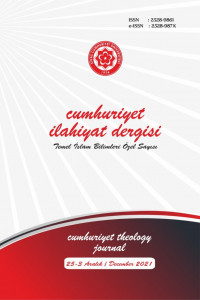Şîa Ricâl Tenkidinde Teopolitik Temayül Şiî Ahmed b. Hilâl el-Abertâî’nin Nâsıbî ve Ğâlîlikle İtham Edilmesinin Tenkidi
The Theopolitic Tendency in the Shia Rijāl Criticism: The Criticism of the Shiite Aḥmad ibn Hilāl al-ʻAbertāī Accused of Nāsibī and Ghālī
Author(s): Yusuf OktanSubject(s): Theology and Religion, Islam studies, Philosophy of Religion, Hermeneutics, Politics and Identity
Published by: Cumhuriyet Üniversitesi İlahyat Fakültesi
Keywords: Hadith; al-Jarh and Taʻdīl; Shiʻa; Nāsibī; Ghulāt; Damnation;
Summary/Abstract: This article analyzes the position of Ibn Hilāl, who is regarded as nāsıbī and ghālī, in the science of Shia rijāl, his reports and the validity of the accusations against him. It is found that narrators are criticized for various reasons in the science of Shiʻa rijāl. Some of them are the Shiite followers that the imams cursed and wanted to be kept away from their adherence. It is seen that the narrations reported by some of the narrators are included in the main sources of Shiite hadith, albeit these narrators were cursed by the innocent imams. Ahmed Ibn Hilāl (d. 267/880) is one of these narrators cursed by the imams and his name is found in the report (the isnād) of many early narrations. Ibn Hilāl, one of the close companions of Shia's 10th imam Ali b. Muḥammed al-Hādī (d. 254/868) and 11th imam Ḥasan al-ʻAskarī (d. 260/874), was first cursed by the letter of al-Askarī allegedly sent, and the Shiite followers were ordered to move away from him. Ibn Hilāl refused to accept the ambassadoriality of Muḥammed b. Osman (d. 305/918), the ambassador of the 12th Imam. Thus, he was cursed by Muḥammad al-Mahdī as well. In later periods, Ibn Hilāl was accused of being nāsıbī and ghālī. However, there are also some Shiite scholars who supported (tavthîk) Ibn Hilāl. In the Shi'a tradition, Nāsibism indicated the meaning of hating ʻAli and Ahl al-bayt or feeling anger towards them. Later on, this meaning has been changed into a meaning including the haters of ʻAli and then the Shiʻa Nāsibism is regarded as a position towards Shiʻa outside of Shiʻa. Ghulāt is a form of a belief generally found in the Shi'a tradition. In the belief of Ghulāt, holiness is attributed to the imams. When the Shiite sources are examined, it can be seeb that Ibn Hilāl represents neither a ghālī nor a nāsıbī position. In the Shiʻa, when the narrator leaves his sect, his narrations are evaluated differently. Therefore, among Ibn Hilāl's narrations only those which narrated before he left can be accepted. The likely reason for this attitude can be those narrators such as Ibn Hilāl brought in many narrations to the Shiite hadith literature. Ibn Bābeveyh and Sheikh Sadūk reported many narrations that includes Ibn Hilāl in their report chain (the isnad). Among these narrations, they criticized only one. Again, in the 4th century of Hijrī, Numānī, al-Hazzāz, Ibn Qavlaveyh and Mufīd reported many narrations transmitted by Ibn Hilāl. However, none of them mentioned about the negative perception on Ibn Hilāl in any of these narrations. This shows that Ibn Hilāl was not regarded as nāsıbī or ghālī in the eyes of the these scholars. As regards to, Tūsī, in the 5th century after Hijra, claimed that Ibn Hilāl was a ghālī and he was accused of being an adherent to this religion. He narrated in sum fifty narrations that included Ibn Hilāl in the report chain, but Tūsī criticized only three of them because of including Ibn Hilāl. The reason why Ibn Hilāl was accused of being nāsıbī and ghālī, which Shiʻa deemed the worst, was probably related to the political conditions of that period. On the other hand, there is no report that Ibn Hilāl shared a nāsıbī and ghālī thought or had a tendency towards them. It is obvious that if Ibn Hilâl, who has an important place in the eyes of the Shiite community, does not accept the second ambassador of al-Mahdī, and that this would cause discord among the followers. This complex situation was tried to be remedied by letters alleged to have been written by the imams, cursing Ibn Hilâl and ordering them to stay away from him. Later, Ibn Hilāl was accused of being a nāsıbî or ghālī who expressed the attitudes and thoughts that Shiʻa saw the most distant from him. Sadūk first reported the narration that Ibn Hilāl was Nāsıbî. Tūsī, on the other hand, described Ibn Hilāl as ghālī in the 5th century (after hijra). This study tries to reveal that there is no explicit evidence that proves Ibn Hilāl’s nāsıbī or ghālī position.
Journal: Cumhuriyet İlahiyat Dergisi
- Issue Year: 25/2021
- Issue No: 3
- Page Range: 1299-1318
- Page Count: 20
- Language: Turkish

